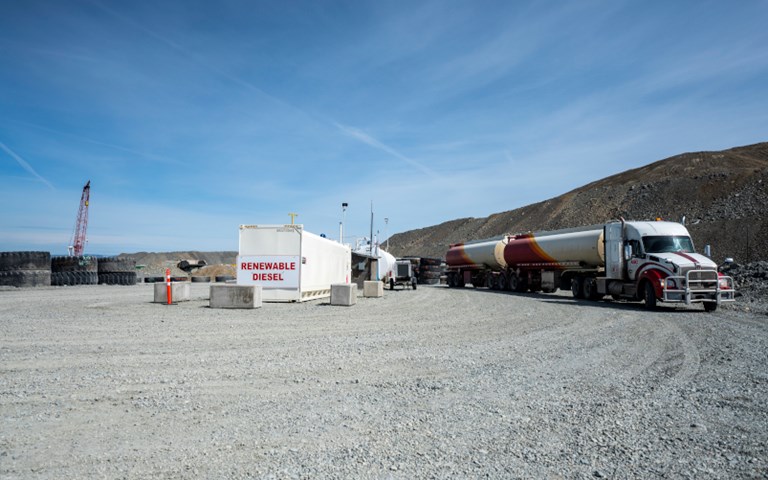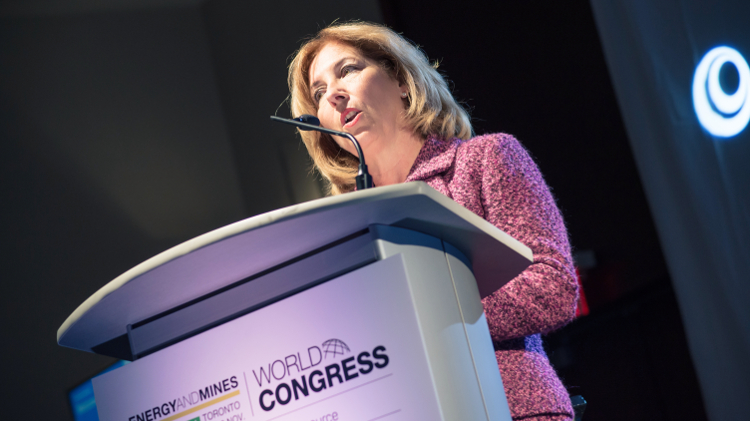Making efforts to reduce greenhouse gas emissions, such as by using renewable diesel, is important if Copper Mountain Mining Corp. wants to reach net-zero emissions, but the company must also be able to track those emissions, and that is where the blockchain-based Mines Digital Trust comes in. Courtesy of Copper Mountain Mining Corp.
Last fall a made-in-Canada mining-emissions tracking ecosystem made its debut at the United Nations Climate Change Conference (COP26) in Glasgow, Scotland.
In a video presented at the conference, Bruce Ralston, British Columbia energy, mines and low carbon innovation minister, previewed the Mines Digital Trust (MDT) ecosystem, a blockchain-based system that will allow B.C. mining companies to share verified evidence of their environmental, social and governance practices, including their annual greenhouse gas (GHG) emissions, based on provincial data. The ecosystem was developed in partnership with IBM and Copper Mountain Mining Corp.
Don Strickland, Copper Mountain’s chief operating officer, said he hopes the ecosystem will evolve to the point where consumers can get “the full story” on a product – from an electric vehicle to a new cell phone – and its GHG emissions intensity when they purchase it.
“If you have the opportunity to buy a vehicle and can scan a barcode and find it has a responsible production credential and say, ‘I’m going to buy brand X because it’s responsibly produced and I want to support that,’ you will drive the people producing metals [to produce more responsibly],” he said.
MDT is just one of a host of emissions-tracking tools being rolled out for the mining sector by consortiums, researchers, governments and technology providers from around the world. While many mining companies track emissions data internally, these technologies are aiming to make the industry’s emissions profile more transparent and accessible to the public as well as to present companies with scenario-modelling options for emissions reduction.
Leveraging blockchain
MDT’s COP26 appearance was a public, initial proof of concept to demonstrate the open blockchain technology, which involved transferring a digital GHG credential with verified emissions data on Copper Mountain’s operation from the provincial government into the company’s digital wallet.
Work continues on the blockchain to allow companies to share their emissions data with auditors, suppliers, buyers, investors and other stakeholders and to introduce “checks and balances” that add to its credibility. MDT’s creators want to add real-time updating capabilities, meaning if an auditor found a discrepancy in a mine’s emissions data, that information could be immediately entered and visible to all blockchain participants.
Mining companies will be able to use a QR code to share carbon emissions data from MDT with the Open Climate network, a blockchain-based global climate accounting system being developed by the Yale Open Innovation Lab, OpenEarth Foundation and others.
Modelling future emissions
Researchers at the University of Queensland’s Sustainable Minerals Institute see their Greenhouse Gas Emissions Management Tool (GGEMT) not just tracking mining emissions but also helping companies to map their lifecycle Scope 1 and 2 emissions and to simulate reduction efforts.
GGEMT uses data on production and performance, ore body properties, energy and fuel consumption, and direct and indirect emissions intensity for each production stage to visualize a mine’s carbon emissions from mine to market, said Mohsen Yahyaei, an associate professor at the university. Users can simulate a range of scenarios by changing various data points or adding in Scope 1 or 2 reduction initiatives; they can also compare scenarios over a 17-year time horizon.
“The outputs can be used as a guideline to prioritize production stages that have the most impact on GHG reduction and identify [the most effective] mitigation plans,” Yahyaei said.
Global research and consulting group Wood Mackenzie’s Emissions Benchmarking Tool (EBT) takes a different tack, drawing on a combination of mining and metals companies’ public sustainability documents and its own in-house work on many operations to create emissions profiles of mines around the world, spanning a range of commodities.
James Whiteside, Wood Mackenzie’s head of corporate for metals and mining, said mining companies are by far the tool’s biggest client base. EBT has also been increasingly used by equity researchers, bankers involved in mining transactions, traders and consumers.
EBT allows companies to compare themselves against their peers and find areas to decarbonize. Users can also forecast commodity, company or asset emissions beyond 2030, and even break that forecast down into Scope 1 and 2 emissions.
The forecasts are built from Wood Mackenzie’s work costing and valuing assets, Whiteside said, which involves understanding all the various cost components of a site as well as the asset’s production stage and mine life. A mature copper operation, for example, might be increasing its strip ratio while its head grade falls, increasing total material movement and energy usage over time. The company then aligns that information with emissions factors for diesel and the site’s power source to project emissions forward.
Data challenges
Emissions monitoring and modelling tools across the board each face a common challenge: quality data.
When the Australian researchers began developing GGEMT, it quickly became clear there are many factors that can influence a site’s GHG profile and the connections between them are not well understood, Yahyaei said. For instance, “the link between electrification of various stages of mining and the GHG emissions intensity, and incorporating Scope 3 emission reduction solutions into the tool requires research to understand the underlying factors [that] link to GHG emissions and model their interdependencies.”
To try to account for those connections, GGEMT uses what is called system dynamic modelling – a type of simulation that hypothesizes and uses connections across processes, to identify dependencies between variables that could affect a site’s emissions. But Yahyaei said the tool currently looks at Scope 1 and 2 emissions at a “very high level.”
He also noted that due to a lack of sensors for direct measurement of GHGs, companies generally calculate emissions based on estimates, limiting the tool’s accuracy. The Sustainable Minerals Institute is currently developing a consortium of mining companies, technology providers and researchers to do further research that could improve GGEMT’s capabilities.
Whiteside said Wood Mackenzie also had to think through how to get consistent data because companies’ approaches to public sustainability reporting and their level of detail vary significantly. The company reviewed technical papers, footprint analyses and sustainability reports to get the most comprehensive picture.
EBT also calculates GHGs on a carbon-dioxide-equivalent basis, following the standards set by the Greenhouse Gas Protocol, which not all mining companies do. Each of the GHGs has different global warming potential (GWP) values on a CO2-equivalent basis, using different GWP factors has a huge influence on how methane emissions are reported, Whiteside said.
“[There are] a lot of site-specific factors that wouldn’t come through in just a calculation: there are different processes going on that we are now aware of, and in some ways made our analysis overall a lot more precise,” he said.
Looking at Scope 3
Data are also an issue when it comes to calculating Scope 3 emissions, said Mohammed Ali, vice-president of sustainability and regulatory affairs at Agnico Eagle Mines, which uses tools created by the Greenhouse Gas Protocol to calculate its emissions. This is partially because of where mining is in the supply chain. Manufacturers, for example, have steel or aluminum suppliers with well-developed emissions profiles that allow for a clear Scope 3 picture; mining’s Scope 3 footprint, meanwhile, tends to come from consumables, not all of which have clear emissions pictures. (Two exceptions are diesel production and vehicle tires.)
Then there is the question of how to calculate these emissions. One approach is to multiply the mass or volume of material purchased from a supplier by the supplier’s data on how many kilograms of CO2 equivalent is produced for each kilogram of product, and do a separate calculation for the distance the materials travelled to site.
Another approach, called an economic input/output model, has started to gain traction and acceptance by the GHG protocol industry, Ali said. This method looks at how much a company spends on upstream consumables as a fraction of that overall industry: for example, if a mining company spends $100 on a consumable, and the industry that makes the consumable has $100 million in revenue, the mining company’s Scope 3 footprint for that purchase is one-millionth of that industry’s total contribution to total GHG emissions.
Wood Mackenzie built out Scope 3 capabilities in its EBT for a couple of commodities, but Whiteside noted there are different complexities for each commodity. With copper, it is able to track concentrate from mine to smelter. But iron ore is more complicated: the product itself will determine whether the iron is sold to a steel mill with a blast furnace, or one using a less emissions-intense direct-reduced iron (DRI) process. Iron ore emissions also differ on a regional basis, and while the company knows miners are selling more to India versus China, Europe and the United States, companies don’t disclose the specifics. As well, many sales are done through traders and are therefore obscured.
MineHub Technologies, a Vancouver-headquartered company that created a blockchain platform for real-time mining and metals supply chain tracking, launched a carbon emissions tracking capability in December that chief executive officer Arnoud Star Busmann said is meant to address Scope 3 challenges.
“[Companies] take an average and say, ‘from this port to [the site], these are the average emissions per kilometre for fuel.’ It doesn’t take into account delays, it’s just pure distance. It’s a rough estimate,” Star Busmann said, adding that it means companies could be under- or overestimating their Scope 3 footprint.
MineHub’s platform, which tracks a shipment of material from mine to eventual endpoint, now allows all players to add emissions data. Copper miners, for example, can include data on the Scope 1 and 2 emissions intensity of the copper they are shipping, along with its copper and arsenic content. Their suppliers can do the same, giving miners a clearer picture of their upstream and downstream emissions.
Star Busmann said the company is building in an analysis capacity this year, specifically for mining companies. “Big companies need to demonstrate continuous improvement in the reduction of their total emissions; investors want to see those go down,” he said.
“For each customer, we have data for the shipment, product, the Scope 3 emissions for each producer. Then you can start slicing and dicing your inventory and say, for example, ‘most of our emissions come from this [downstream buyer].’ … You can start optimizing the portfolio.”
Net-Zero Challenge will run throughout 2022. It will examine the challenges involved with reducing greenhouse gases and eliminating carbon footprints, and it will also look at the opportunities those actions can represent. If you have something to contribute, reach out to us at editor@cim.org.
PROUDLY SPONSORED BY






